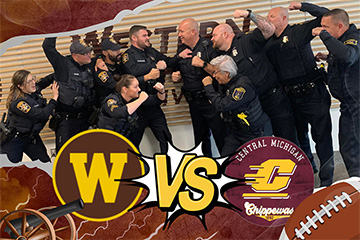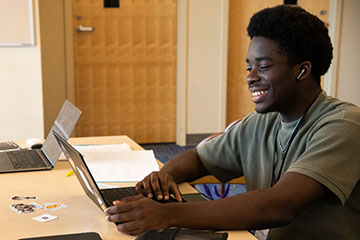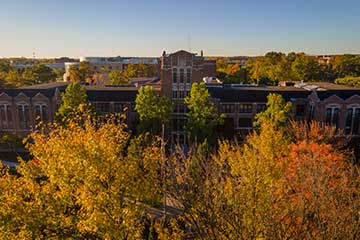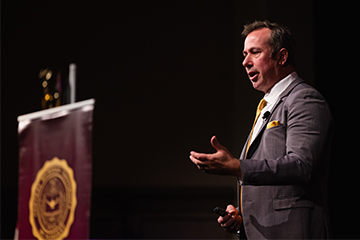New technology kicks off historic Finch celebration
QR codes unlock videos showcasing one of CMU’s most storied buildings
What started as a class project in a Recreation, Parks and Leisure Services Administration course will kick off the celebration of the 75th anniversary of one of Central Michigan University’s most storied buildings.
An interpretive trail commemorating the history of Finch Fieldhouse is already live. It is constructed of plaques around the building that contain QR codes that, when scanned, will open a video that highlights a piece of Finch history.
There are seven stops along the trail, each focusing on a piece of Finch history rooted in the spot on which the plaque stands.
The trail was already under development when Jordan Bruursema, the course instructor, found out that a celebration of the building’s 75th anniversary was being planned, said Tim Otteman, chairman of the RPL program.
Bruursema said that his courses have created interactive trails in the hallways of Finch before, but usually for wild places. But, natural places often have a component of human history that is important to remember.
“The history of it needs to be celebrated,” he said.
What sets the Finch interpretive trail apart from the other class projects is that it is now a permanent fixture in the building.

Celebrating Finch’s history
Students researched Finch’s history at Clarke Historical Library, which houses the archives of CMU’s history, said Bryan Whitledge, The Clarke’s public services librarian.
Staff at The Clarke provided the students with photos and fact-checking and information about a different QR code display that involved plaques in different campus buildings. The panels were part of a project by broadcasting faculty Will Anderson.
Bruursema’s students provided narration for the trail built for Bruursema’s course. For the permanent interpretive trail, they turned to a voice familiar with CMU athletics, Adam Jaksa.
“Adam was the perfect choice,” Otteman said. “A voice CMU is familiar with and a guy I love to work with.” Finch’s history has deep connections to CMU athletics.
Basketball teams once played in the fieldhouse proper and a men’s gymnastics team competed in the room containing the rock climbing wall. The ROTC office used to be a swimming pool.
CMU’s football field and baseball stadium used to occupy the land east of Finch. Now, a large, open green space and the Health Professions Building sit there.
All those locations have plaques marking their importance in the history of Finch. So, too, do the Finch press box and the hallway that once housed coach’s offices. Today, those are all faculty offices. A map outlining the locations is inside the building entrance.
Celebration planned for March
A celebration of all that history will take place from 11 a.m. to 2 p.m. on March 22. Much of it will focus on the people who filled the building with its history, legendary coaches who fielded championship teams while also shaping young minds as faculty members, Otteman said.
Relatives of some of CMU’s past coaches plan to attend, he said.
It will also provide an opportunity to reflect on how much change the building has seen since its cornerstone was laid by President Charles Anspach in 1950.
A timeline with pictures will stretch along the wall in Finch 113, a classroom in the building’s northeast corner where the celebration will take place, Otteman said.
The wall itself is a silent historical marker highlighting the change that Finch has seen, Otteman said. It was once a movable, accordion wall that divided two rooms. The division was made permanent, slicing one gymnasium space into two large rooms.
History on permanent display
Some of Finch’s history is on display in the building’s main hallway.
One item is a pennant from a very brief period of CMU history when the school was called Central Michigan College. Anspach renamed it Central Michigan University in 1959, shortly before his retirement, Otteman said.
He originally saw the pennant for sale on eBay and contacted the owner, who was glad to give it to the university for the price of shipping, he said.
It sits next to the trowel Anspach used to lay Finch’s cornerstone. It was during a period of expansion at CMU, and Anspach used the trowel to lay cornerstones for several other historic buildings on campus, each marked on a piece of paper on the trowel blade.
Like the interpretive trail, those are right now available for the public. They’ll also be viewable for the March 22 celebration which will include souvenirs, stickers, snacks and more.



